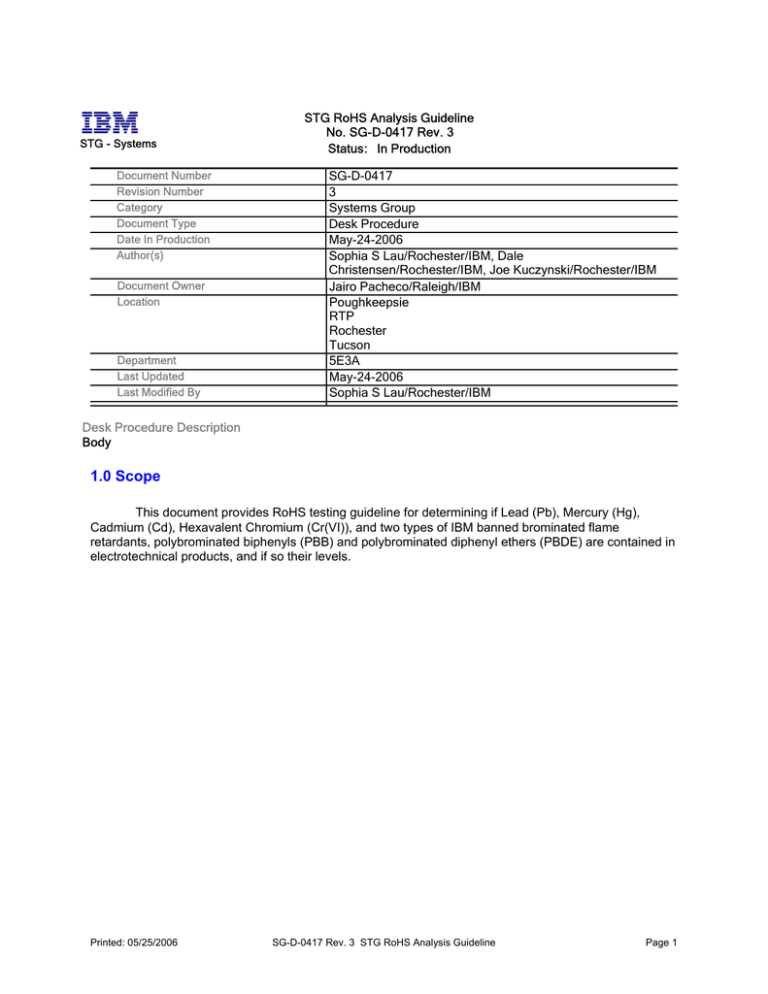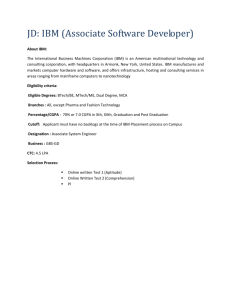
STG - Systems
Document Number
Revision Number
Category
Document Type
Date In Production
Author(s)
Document Owner
Location
Department
Last Updated
Last Modified By
STG RoHS Analysis Guideline
No. SG-D-0417 Rev. 3
Status: In Production
SG-D-0417
3
Systems Group
Desk Procedure
May-24-2006
Sophia S Lau/Rochester/IBM, Dale
Christensen/Rochester/IBM, Joe Kuczynski/Rochester/IBM
Jairo Pacheco/Raleigh/IBM
Poughkeepsie
RTP
Rochester
Tucson
5E3A
May-24-2006
Sophia S Lau/Rochester/IBM
Desk Procedure Description
Body
1.0 Scope
This document provides RoHS testing guideline for determining if Lead (Pb), Mercury (Hg),
Cadmium (Cd), Hexavalent Chromium (Cr(VI)), and two types of IBM banned brominated flame
retardants, polybrominated biphenyls (PBB) and polybrominated diphenyl ethers (PBDE) are contained in
electrotechnical products, and if so their levels.
Printed: 05/25/2006
SG-D-0417 Rev. 3 STG RoHS Analysis Guideline
Page 1
2.0 Determination of Cd, Pb, and Hg
RoHS Determination of Cd, Pb, and Hg in Metallic and Polymeric Samples
Determination of Cd, Pb, and Hg in Metallic Samples
2.1 Metal Samples
The determination of Cd, Pb, and Hg in metals is accomplished by dissolving the sample in appropriate
acids followed by analysis by ICP/AES, ICP/MS, AAS, or some other suitably sensitive technique. The
wide variety of metallic samples and the choice of appropriate acids is beyond the scope of this
procedure. In general, nitric and hydrochloric acids should be the first choice for most samples. For more
unusual samples the use of sulfuric acid, phosphoric acid, hydrofluoric acid, and fluoroboric acid may be
required. In all cases, however, there must be no residual precipitates or undissolved sample remaining.
Determination of Cd, Pb, and Hg in Polymeric Samples
2.2 Approach
The determination of Mercury, Hg, in a polymeric sample is to be done by Direct Mercury Analysis (e.g.
Milestone Inc) following EPA Method 7473 “Mercury in Solids and Solutions by Thermal Decomposition,
Amalgamation, and Atomic Absorption Spectrophotometry.” Additionally, Milestone Application Note
HG-19 “Determination of Mercury in Plastic” provides procedural guidance. No additional tests need to be
done, however, a mercury-containing plastic quality control sample should be run on a regular basis to
insure quality.
The determination of Cadmium, Cd, and Lead, Pb, in a polymeric sample is to be done by two
procedures. First, a quantitative procedure such as EN1122 is to be performed in which the sample is
milled to a fine consistency and digested with acid. This procedure demands a choice of acids which
depends upon the polymer. For example, polyethylene, polypropylene, polyvinyl chloride need to use a
combination of sulfuric acid, hydrogen peroxide, and nitric acid in order to be effective, while nylons may
generally be decomposed by nitric acid alone. Alternatively, a quantitative dry ashing procedure may be
used, however, low results can be obtained for certain polymers unless the furnace is slowly programmed
to avoid flaming and loss of volatiles. Regardless of which quantitative procedure is chosen, a second
semi-quantitative procedure (XRF) must be used to confirm the quantitative results. This redundancy in
testing serves to provide additional confidence in testing results. The quantitative dry ashing/acid
digestion procedure is described below. In all cases both tests need to be performed. XRF test results
are usually only semi-quantitative since standards made from the same matrix as the sample are usually
unavailable. For this reason detection of any Cd or Pb in a sample should result in the sample being
considered a non-compliant sample, regardless of the number generated by the XRF. A sample is only
considered compliant when it passes both the quantitative dry ashing test and the XRF test.
If the quantitative procedure results in a number which is non-compliant or the XRF detects Cd or Pb, the
sample is non-compliant.
2.3 Dry Ashing Method Summary (for Cd and Pb)
Polymeric samples are dry ashed in a muffle furnace followed by a nitric acid digestion of the ash. This
extract is diluted as necessary and analyzed by ICP/AES, ICP/MS, or AAS for cadmium and lead content.
Printed: 05/25/2006
SG-D-0417 Rev. 3 STG RoHS Analysis Guideline
Page 2
Procedure:
Ashing - A suitable amount of sample, generally 0.2g to 1.0g, is weighed to the nearest 0.1mg, and
placed into a porcelain crucible. This crucible is placed into a programmable muffle furnace
initially set at 200C and slowly ramped to 460C. A crucible cover placed on top slightly offset so
that vapors can escape. The crucible cover should be removed after charring to allow better
oxidation of the sample. The duration in the muffle furnace is typically 3-4 hours, but ultimately
depends on the sample. If the sample or the crucible appear to have carbonaceous matter on
any of the surfaces, the time should be extended until this material is completely
oxidized/vaporized. Once all the carbonaceous material is gone, the crucibles may be removed
from the muffle furnace and allowed to cool.
Acid Digestion – Ten milliliters of concentrated nitric acid is added to the ashed remains in each
crucible and the crucible heated on a hotplate or digestion block at 90-100C. One hour is
typically sufficient for this step. The crucibles are then removed from heat and allowed to cool.
The contents are then quantitatively transferred to polypropylene or glass container and the
volume brought to 50 milliliters (20 milliliters may be more appropriate if low levels of Cd and Pb
are expected). The samples may have to be filtered at this point to remove suspended particles if
they are present.
Analysis – The digest may be analyzed with any of the common analytical techniques such as AAS,
ICP/AES, or ICP/MS. Samples should be diluted as appropriate to maintain Cd and Pb
concentrations within the instrument calibration range.
Calculations – The Cd and Pb concentration values (in ug/ml) should be multiplied by any dilution factors
(if used) and by the volume (in ml) of solution in the initial container. This value represents the amount (in
micrograms) of the Cd and Pb present in the sample, and should be divided by the sample weight (in
grams) to arrive at a concentration value in ppm units.
Printed: 05/25/2006
SG-D-0417 Rev. 3 STG RoHS Analysis Guideline
Page 3
3.0 Determination of PBB and PBDE in Polymeric Materials
Determination of Polybrominated Biphenyl (PBB) and Polybrominated Diphenyl
Ether (PBDE) in Polymeric Materials
3.1 Scope
This document describes the methodology for verifying IBM suppliers’ material declaration on compliance
to two classes of IBM banned brominated flame retardants (BFRs): polybrominated biphenyl (PBB) and
polybrominated diphenyl ether (PBDE). This ban applies to all 209 congeners of PBBs and all 209
congeners of PBDEs, including decabromodiphenyl ether (BDE-209) which is currently exempted by EU
RoHS. Any detectable levels of these two classes of BFRs, even thought below EU RoHS allowable limit,
are considered noncompliant to IBM specification.
3.2 Approach
A fast and simple qualitative analysis by X-ray Fluorescence (XRF) can be performed to determine if
bromine (Br) is present in the homogeneous polymer. If the presence of Br is confirmed by XRF, further
information should be obtained from the supplier on the specific brominated flame retardant (BFR) used
in the material; not all BFRs are banned by IBM.
For analysis of PBBs and PBDEs in a homogeneous polymer, a soxhlet extraction followed by Gas
Chromatography-Mass Spectrometry (GC/MS) shall be employed to determine if any of the PBB or PBDE
congeners are present in the homogeneous polymer matrix. Optionally, a 16 hour room temperature
extraction followed by GC/MS (SIM mode) analysis can be performed as a preliminary screen test. If PBB
or PBDE congeners are detected in the screen test, the polymer is considered noncompliant. If the
screen test is negative for PBBs or PBDEs, a soxhlet extraction followed by GC/MS shall be performed to
determine compliance.
In general, the solubility of the polymer matrix and the particle size of the sample matrix greatly influence
the extraction efficiency, and thus, the proper detection of PBBs/PBDEs for compliancy. Therefore,
appropriate extraction solvent(s) and sample grinding (500 um particle size, especially for partially soluble
and insoluble polymer matrixes) prior to analysis are crucial for accurate testing.
3.3 Additional Equipment
A grinding instrument capable of reducing sample to a size of 500 um or smaller.
3.4 Procedure
The general procedure recommended by BAM “Determination of Pentabromination Diphenylethers and
Octabrominated Diphenylether in Polymers” shall be followed with the following additions:
1) Samples are ground to a size of 500 um or smaller before extraction
2) Depending on the type of polymer, appropriate solvent(s) should be used to dissolve the polymer
matrix. If the nature of the polymer is unknown, toluene should be used as universal solvent. For specific
polymers, the following solvents should be used:
Printed: 05/25/2006
SG-D-0417 Rev. 3 STG RoHS Analysis Guideline
Page 4
· Toluene for ABS, HIPS and PC/ABS
· Propanol for Polyamides and Polyesters
· 5/25 Dichloromethane/cyclohexane for Polyolefins
3) The analysis of PBBs and PBDEs is carried out in SIM (Single Ion Monitoring) mode with the mass
traces given in tables below:
Reference masses for the quantification of PBBs
Ions monitored in the extract
Mono-BB
233.9
231.9
Di-BB
309.8
313.8
311.8
Tri-BB
387.8
391.8
389.8
Tetra-BB
307.8
467.7
309.8
Penta-BB
385.7
545.6
387.7
Hexa-BB
465.6
627.5
467.6
Hepta-BB
543.6
705.4
545.6
Octa-BB
623.5
627.5
625.5
Nona-BB
701.4
705.4
703.4
(863.4)
Deca-BB
781.3
785.3
783.3
(943.1,215.
8,
382.6,384.
5)
( ): Optional ions; Bold: Quantification ions; Underlined: Identification ions
Reference masses for the quantification of PBDEs
Ions monitored in the extract
Mono-BDE
249.9
247.9
Di-BDE
325.8
329.8
327.8
Tri-BDE
403.8
407.8
405.8
Tetra-BDE
323.8
483.7
325.8
Penta-PDE
401.7
561.6
403.7
Hexa-BDE
481.6
643.5
483.6
Hepta-BDE
559.6
721.4
561.6
Octa-BDE
639.5
643.5
641.5
(801.3)
Nona-BDE
717.4
721.4
719.4
(879.2)
Deca-BDE
797.3
799.3 (
799.3
231.8,
398.6,
400.5,959.
1)
( ): Optional ions; Bold: Quantification ions; Underlined: Identification ions
Printed: 05/25/2006
SG-D-0417 Rev. 3 STG RoHS Analysis Guideline
Page 5
Printed: 05/25/2006
SG-D-0417 Rev. 3 STG RoHS Analysis Guideline
Page 6
References
Document Type
Document Number
Document Name
Document Management
Effective
Date
May-24-2006
Next
Review
Date
May-24-2007
Review Interval
(Maximum Review Interval =
12 months)
Retention Period
12 months
24 months
Revision History
This Version
3
Created by
Sophia S
Lau/Rochester/IBM
Date
May-23-2006
2
Sophia S
Lau/Rochester/IBM
May-04-2006
1
Sophia S
Lau/Rochester/IBM
Feb-28-2006
0
Sophia S
Lau/Rochester/IBM
Feb-24-2006
Short Description
Removed Cr(VI) Test
Method
Previous Versions
Added changes from Mike
Cronin
Added other test
procedure
Initial Version
Long Description
Edits to this Revision
5/24/2006 1:15:28 PM - Sophia S Lau/Rochester/IBM
5/24/2006 10:07:31 AM - Sophia S Lau/Rochester/IBM
5/23/2006 2:10:57 PM - Sophia S Lau/Rochester/IBM
Approval Information
Reviewers
Approvers
Select if Approvers will be required to re -enter
their password prior to approving or rejecting
the document.
Sophia S Lau/Rochester/IBM
Joe Kuczynski/Rochester/IBM
Dale Christensen/Rochester/IBM
Wayne McKinley/Tucson/IBM
Charles C Sloop III/Raleigh/IBM
Jairo Pacheco/Raleigh/IBM
N
Users
Editors
People who can change
make changes
Printed: 05/25/2006
Jairo Pacheco/Raleigh/IBM
Sophia S Lau/Rochester/IBM
Dale Christensen/Rochester/IBM
Joe Kuczynski/Rochester/IBM
[QMXADMIN]
SG-D-0417 Rev. 3 STG RoHS Analysis Guideline
Page 7
Mona M Aakre/Rochester/IBM
Diane Mitchell/Rochester/IBM
Cheryl Wangsness/Rochester/IBM
Dale R Mosher/Poughkeepsie/IBM
Diane Gonsalves/San Jose/IBM
Dale Stuemke/Austin/Contr/IBM
Victoria Cyr/Poughkeepsie/IBM
Margaret Brinkel/Morrisville/IBM
Daniel G Demer/Tucson/IBM
Carmen Clark/West Palm Beach/IBM
Access restricted to
History Log
Date Created
Date Draft Complete
Date Review Complete
Date Approved
Date Distributed
Date Obsolete Requested
Date Obsolete
Date Withdrawn
May-23-2006
May-23-2006
May-24-2006
May-24-2006
May-24-2006
Sophia S Lau/Rochester/IBM
Sophia S Lau/Rochester/IBM
Sophia S Lau/Rochester/IBM
Automatic System
_____________________________________________________________
© 2006 IBM Corporation, All Rights Reserved Worldwide
WW SG Document Library Control / D01DB034 / q_dir\qmx\serv\qrodlc .nsf
End of Document
Printed: 05/25/2006
SG-D-0417 Rev. 3 STG RoHS Analysis Guideline
Page 8



